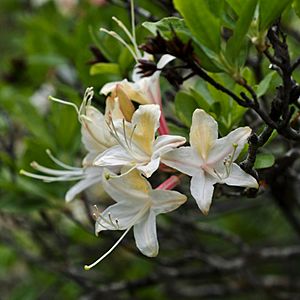Western azalea facts for kids
Quick facts for kids Western azalea |
|
|---|---|
 |
|
| Scientific classification | |
| Kingdom: | |
| (unranked): | |
| (unranked): | |
| (unranked): | |
| Order: | |
| Family: | |
| Genus: | |
| Subgenus: |
Pentanthera
|
| Section: |
Pentanthera
|
| Species: |
R. occidentale
|
| Binomial name | |
| Rhododendron occidentale Torr. & A.Gray
|
|
Rhododendron occidentale, also known as the western azalea or California azalea, is a beautiful type of flowering plant. It's one of only two kinds of Rhododendron plants that lose their leaves in winter (called deciduous) and grow naturally in western North America.
You can find the western azalea as far north as Lincoln and Douglas Counties in Oregon. It also grows south into the mountains of San Diego County in California. This plant usually lives in the coastal areas of western North America. You can also spot it in the Cascade and Sierra Nevada mountain ranges. However, it does not grow east of these mountains.
What it Looks Like
The Rhododendron occidentale is a shrub that can grow up to 5 meters (about 16 feet) tall. Its leaves are deciduous, meaning they fall off in autumn. Each leaf is usually 3 to 9 centimeters (1 to 3.5 inches) long and 1 to 3 centimeters (0.4 to 1.2 inches) wide.
The flowers are quite large, about 3.5 to 5 centimeters (1.4 to 2 inches) across. They have five main parts, called lobes, on their petals (the corolla). The color of the flowers can be white or pink. Often, they have a bright yellow spot or blotch on them, which makes them even more special.
This plant shows a lot of variety in how it looks. Its genetic diversity, meaning the different traits it can have, seems to be highest near the border between Oregon and California. The western azalea can even grow in special soils called serpentine soils. These soils are so unique that finding them, along with surface water, can be a sign that western azaleas are nearby in southern Oregon.
Because of this, it's part of a special group of plants found in the serpentine barrens of the Siskiyou Mountains. Other plants in this unique area include Darlingtonia californica (a type of pitcher plant) and Cypripedium californicum (a beautiful orchid). Western azaleas are usually found in wet areas, but their roots don't like to be underwater. They need more moisture and more sunlight than another type of rhododendron called Rhododendron macrophyllum, which is an evergreen plant found in similar areas.
History and How People Grow It
Explorers in western North America first wrote about Rhododendron occidentale in the 1800s. At one time, people thought the different types found in various places were separate species. In 1850, a man named William Lobb sent seeds of this plant to the Veitch Nursery in England.
The western azalea was very important in creating new types of azaleas that lose their leaves. These new hybrid azaleas were developed in Great Britain, like the famous Exbury azaleas.
Throughout the 1900s, people continued to explore and study this plant. Several generations of rhododendron fans looked for unusual forms of the western azalea. They wanted to use these unique plants in gardens and to record them for science. Many of these special forms are now kept safe at the Smith-Mossman Western Azalea Garden. This garden is located at the Lake Wilderness Arboretum in Maple Valley, Washington state, USA.
See also
 In Spanish: Azalea occidental para niños
In Spanish: Azalea occidental para niños

